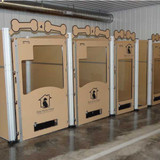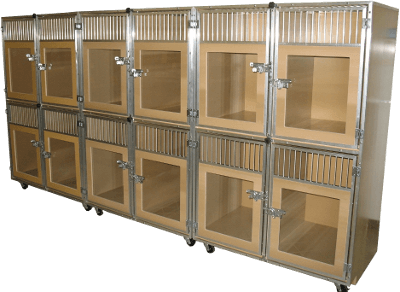What are the best materials to use in my new dog kennel facility?

This is part of a series of blog posts about starting your own dog daycare or boarding business. Click here for the entire series
Starting your own doggy daycare or overnight boarding facility is a daunting task. There are many things you need to consider before deciding on your kennel system.
- Consider how the facility will be cleaned.
- Use materials that are aesthetically pleasing and match your theme.
- Don't forget the essentials like lighting, ventilation, and a well organized layout.

Row of Double-stack kennels on wheels with glass gates.
Getting Started - consider how you will clean the kennels.
You will spend MOST of your time cleaning. That is why I list it as the first thing to consider. If most of your time is spent on keeping things clean - taking steps up-front to reduce the time you spend will save you in the long run.
Most people, when starting a daycare/overnight boarding facility consider the fact that a good clean kennel system is a good thing - but many don't understand fully as to 'why'. Yes, a good clean facility lowers the risk of spreading disease and keeps your critters happy - but it also keeps your customers coming back. If your human customers do not like the look or smell of your facility, they will find another daycare center to drop their animals off. After all, you are providing a 'home away from home' for these beloved pets. If your facility does not look and smell as nice as home, then your customers will find a different place to visit.
A kennel system that is easy to clean - built from materials that are also easy to clean, really add up to savings in the long run. Many kennel manufacturers use laminates to build the kennels. These laminates are usually wood covered in a material that does not absorb water and is easy to clean.
Many states have outlawed the use of wood in kennels because it cannot be sanitized. This not only includes the kennels themselves - but also the trim and decorations in your facility. For this reason, I do not recommend using wood ANYWHERE within the facility.
Other common kennel materials are:
- powder-coated steel
- galvanized steel
- stainless steel
- aluminum
- plastic
Each of these materials has advantages and disadvantages in the kennel-world. For example, while it may be tempting to use stainless steel, the cost is incredibly high. Additionally, you have to be careful how you clean the stainless as certain cleansers (including bleach) can etch the material - removing the protective layer and allowing the steel to rust.
Check out Gator Kennels Materials - and why we use them.
Aesthetics of your kennel system.
I intentionally put aesthetics below cleaning because I am a firm believer of function over looks. It will not matter how beautiful your kennel facility is if you have to spend every minute of your time trying to keep it looking that way. That said, the aesthetics are still very important. Some materials will help enhance the look of your facility and can carry a theme throughout your facility. Another thing to keep in mind is how your kennel facility will "age" over time. Everything looks great when it is brand-new - but some materials seem to wear better than others. Many kennels are manufactured out of steel with some sort of coating to keep it from rusting. This coating WILL be scratched off, chewed off, or certain cleansers can dissolve it off! This causes the steel underneath to be exposed to the water or urine and things start to rust!
Paint can with also be scratched and chewed. It can also be affected by dog urine or your cleaners (making it discolor). For those reasons, I try to limit the paint to areas the dogs cannot access and areas that can be repainted easily (like the lobby). I try to avoid paint in the kennels because it just will not last.
There are kennels made from materials that cannot rust (aluminum or plastic). These tend to cost a little more up-front, but should look less run-down after a few years.
Combined with the materials the kennels are made from, the kennels themselves can have fun colors, custom logo/designs on them or other fun features to make them look less like "jail" and more like a fun place to visit! Check out our blog post about kennel customizing: here.
Creating your kennel facility.
There are many different options for the structure of your facility. You can either build the building from scratch - which will allow you to add in specific features you want. Or you might be taking an existing building and working around the structure that is already in place. Either way, there are some features you shouldn't overlook:
- Lighting
Good light is a welcome sign for your customers. It makes your facility seem more inviting - and less like jail.
- Ventilation
Good ventilation will keep smells from building up - which your human and non-human customers will like. It can also help lower the chance of diseases spreading from one critter to another (if you include filters in your overall ventilation strategy).
- Space
Effective use of space will make your facility look less cluttered and more inviting. First impressions are everything. If you have to crawl over a stack of dog food and squeeze past your computer desk to invite the guest who just walked in the door - your facility will not score very high on first-impressions. Conversely, if your facility is laid out in an orderly fashion and everything seems to have a place then your customers will see you as professional and orderly.

There are also some things to consider when laying out your facility. Some layouts can actually save you money (compared to others) - and some make it easier to handle the dogs! We discuss some of these kennel-specific layouts in another blog posts here.
